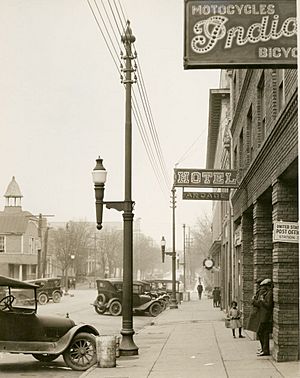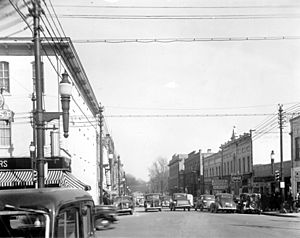East Hargett Street (Raleigh, North Carolina) facts for kids
East Hargett Street is a special street in downtown Raleigh, North Carolina. It was first planned in 1792, making it one of the city's oldest streets. In the early 1900s, it became a very important place for businesses owned by Black people. Because of this, it was often called "Black Main Street" or "Negro Main Street." However, the street faced tough times and saw a decline in business in the 1960s.
Contents
History of East Hargett Street
How the Street Started
East Hargett Street was created in 1792. It was one of the very first streets in Raleigh, North Carolina. The street was named after Frederick Hargett, who was one of the people chosen to help plan the city.
At first, East Hargett Street had both homes and businesses. In 1800, the city's main market was set up there. The area also had many bars, which people called "Grog Alley." The market moved in 1840. But by 1860, East Hargett Street was mostly filled with businesses. It became one of Raleigh's main business areas, like Fayetteville Street.
The "Black Main Street" Era
East Hargett Street was close to Black neighborhoods in Raleigh. In the late 1800s, Black-owned businesses were spread out across the city. They served customers of all races. In 1900, most businesses on East Hargett Street were owned by white people. But there were also nine Black-owned businesses.
After 1902, many Black businesses moved away from Fayetteville Street. This happened as Jim Crow laws became stronger. These laws created strict rules for racial segregation. Black-owned businesses then started to gather along Wilmington Street.
In 1904, Black businessmen James Hamlin and Walter T. Harris opened People's Drug Store on East Hargett Street. Three years later, it was renamed Hamlin Drug. This pharmacy filled prescriptions from Black doctors. It also had a soda fountain that was popular with students. They even had a lunch counter.
In the late 1900s, Calvin E. Lightner wanted to open a funeral business. He was a Black architect and mortician. He first looked for space on Fayetteville Street. But when that didn't work, he found property on East Hargett Street. In 1909, he built the Lightner Building there. In 1911, he started the Lightner Funeral Home. It opened on October 1st, operating from the first floor of his building.
"Every Negro who wanted to into business in Raleigh wanted to be on East Hargett Street because we had built it up. Everybody who came to Raleigh felt he hadn't been to the city until he had been to East Hargett Street."
Calvin Lightner then helped build many other businesses on East Hargett Street. This caused Black-owned businesses to move from Wilmington Street to East Hargett. The street soon became known as Raleigh's "Black Main Street." Black business owners and professionals were drawn to this street. They liked the sense of community. They were also forced off Fayetteville Street due to segregation. Black neighborhoods nearby also grew quickly during this time.
Unlike some other Black business areas, East Hargett Street mostly attracted middle-class customers. It was known as a respectable place.
In the 1910s, Lightner and his brother Ralph ran a car repair garage on the street. In 1921, Lightner built the Lightner Arcade and Hotel. It was right across from the Lightner Building. The arcade quickly became a fun place for Raleigh's Black community. It was one of the best hotels for Black travelers on the East Coast of the United States. Famous musicians like Cab Calloway, Count Basie, and Duke Ellington stayed there. The building also had a movie theater, a restaurant, a barbershop, and the offices of The Carolinian newspaper. Hamlin Drug moved into the building before moving next door.
Also in 1921, W. T. Jomn opened the Royal Theatre on East Hargett. The next year, Lightner built a Mechanics and Farmers Bank branch. This bank opened on January 1, 1923. It was one of only 119 banks in the U.S. at the time to have a branch. It was also the only Black-owned bank to do so. By that year, there were more Black-owned businesses than white-owned ones on the street. Most Black businesses were on the 100 block. Lightner and his brother sold the Lightner Arcade in May 1925.
In 1926, Dr. Lemuel T. Delany built the Delaney Building. With dentist George Evans, he opened the city's second Black dentistry office there. The Great Depression slowed down business growth on East Hargett. However, the Mechanics and Farmers Bank branch was one of only two banks in Raleigh that did not close after the stock market crash. In 1935, Mollie Huston Lee started the first Black public library in Wake County inside the Delaney Building.
By 1940, East Hargett Street was at its peak. It had 51 Black-owned businesses and 27 white-owned businesses. In 1959, there were still 46 Black-owned and 23 white-owned businesses.
The Hamlin family sold their drug store in 1957. The new owners kept the lunch counter open through the 1960s.
Decline and New Beginnings
"I don't think that time will ever come back, and I don't want it to come back. But I miss the way this street used to be."
Building new places on the street slowed down after World War II ended in 1945. In the 1960s, many people started shopping at new malls. This meant fewer people went to downtown Raleigh. By the mid-1960s, East Hargett Street began to lose businesses. Some Black businesses joined bigger companies or moved to find more space. Also, with better civil rights, Black shoppers could now go to more places.
The Lightner Arcade changed owners many times. It then burned down in June 1970. The Delaney family sold their building that year to a Black doctor. He turned the first floor into a restaurant. By 1982, many buildings on East Hargett were empty. The Royal Theatre had been torn down. But some Black businesses still remained. In 1985, the Delaney Building was recognized as an important part of the Moore Square Historic District.
Some small repairs were done to East Hargett buildings in the 1980s. But more serious restoration work began after 2002. A report in 2007 said there were "very little commercial development" and few African American businesses. It also noted problems in the surrounding homes.
Despite these challenges, people started to invest in the street's properties. This happened as the rest of downtown Raleigh became more lively. Hamlin Drug survived the decline. It was one of the last independent drug stores in North Carolina cities. It finally closed in 2017. This made it the last of the old Black-owned businesses from that important era to leave. In April 2021, the Raleigh ArtBeats group and the city government helped paint four murals along the street. These murals celebrate the history of Black businesses there.



